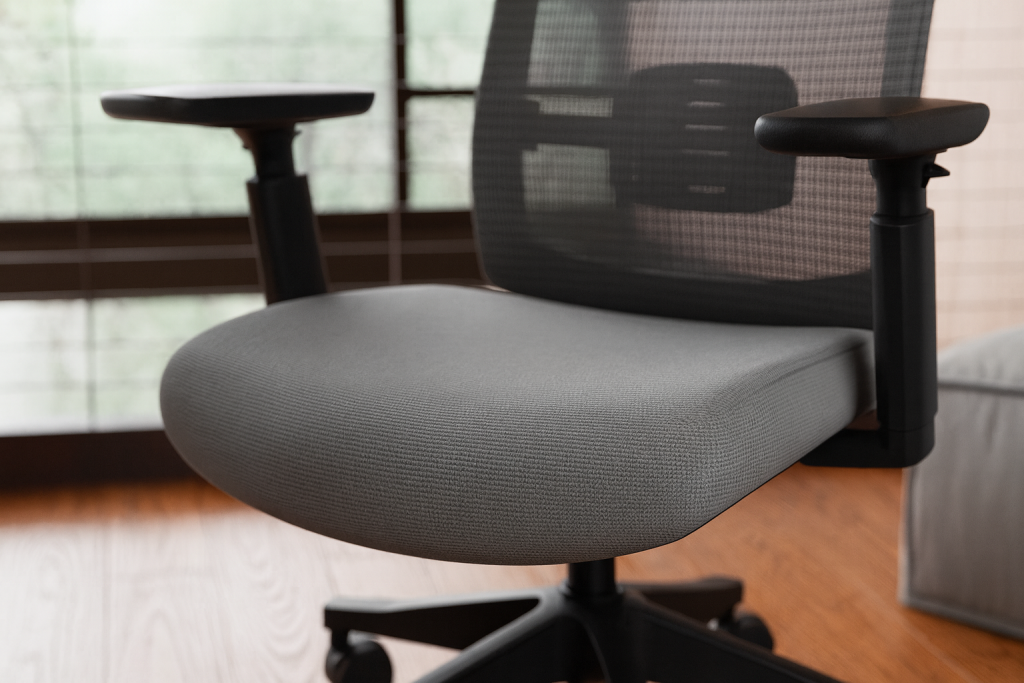If your desk chair keeps sinking, you are not alone. That slow drop toward the floor is annoying, bad for posture, and a real productivity killer. The good news is that most sinking issue problems come from a few simple parts, and you can often fix them yourself without buying a brand-new chair.
This guide explains why a desk chair keeps sinking, how the adjustment mechanism actually works, and which fixes are worth trying. We will walk through quick DIY tricks, when to use a hose clamp or pvc pipes as a temporary solution, and when you should replace the gas cylinder for a long term repair.
Why your desk chair keeps sinking
Most modern task chairs use a pneumatic or gas lift cylinder to change chair height. When you pull the adjustment lever, the cylinder moves up or down and locks at the level you choose. Over time, the internal seals in that cylinder wear out. Air leaks, pressure drops, and the chair slowly sinks whenever you sit down.
Common causes include:
- Worn or leaking gas lift cylinder seals
- Damage to the adjustment mechanism under the seat
- A loose or bent adjustment lever that no longer locks correctly
- Exceeding the weight rating of the adjustable office chair
- Low quality components that simply do not last
If you are using a good ergonomic chair and it still drops, the gas lift is almost always the weak link, not the frame or padding.
Step 1: Confirm the problem
Before trying any repair, make sure you know what is actually wrong.
- Pump the chair to your normal chair height.
- Sit down and stay still for a few minutes.
- If the chair slides down without touching the lever, the gas lift cylinder is failing.
- If it only drops when you move the lever, the mechanism or lever is the main problem.
Also check for oil or dark stains around the cylinder. That is a clear sign of internal leakage and a strong hint that you will eventually need a replacement cylinder.
Step 2: Try the fastest temporary fixes
If you are on a deadline and your desk chair keeps sinking today, a quick fix can hold you over until you have time for a proper repair.
The hose clamp collar
A metal hose clamp is one of the easiest ways to stop a sinking office chair at a fixed height:
- Slide the plastic cover sleeve up to expose the metal cylinder.
- Raise the seat to your ideal chair height.
- Wrap the hose clamp around the exposed metal tube.
- Add a layer of duct tape underneath if the surface is very smooth.
- Tighten the clamp until it holds your weight.
This method locks the chair from sinking any lower, but you lose smooth height adjustments. Think of it as a low-cost, temporary solution that can keep you working for a while.
The pvc pipes support
A second option uses short sections of pvc pipes as solid spacers:
- Measure the length of the exposed metal cylinder at your preferred height.
- Buy pvc pipe with an inner diameter slightly larger than the cylinder.
- Cut the pipe to length, then slice it lengthwise so it can snap over the cylinder.
- Snap one or more pieces around the cylinder until the seat rests on them.
Again, this trick keeps the chair from sinking, even if the gas lift no longer works. It is not very pretty, but it is cheap and does not require special tools.

Step 3: Decide if it is time to replace the gas cylinder
Temporary fixes are fine, but they do not restore your adjustable office chair to full function. If you care about ergonomic posture and want a long term solution, the real repair is to replace the gas cylinder with a new, high quality part.
You should plan to replace the gas cylinder when:
- The chair drops every time you sit, no matter what you do
- The adjustment lever feels loose or fails to lock
- You hear hissing, popping, or grinding from inside the cylinder
- DIY fixes only work for a short time
At that point, a new gas lift cylinder is safer and more reliable than endless band-aids.
Step 4: How to replace a faulty gas lift cylinder
Replacing the cylinder sounds technical, but most people can do it with basic tools. Always follow the manufacturer’s instructions, but the general process looks like this:
- Turn the chair upside down on a table or the floor.
- Pull off the wheels and base. A rubber mallet helps loosen stuck parts.
- Use a pipe wrench to twist and pull the old cylinder from the seat plate.
- Clean any dust or oil from the socket so the new part seats correctly.
- Insert the new replacement cylinder firmly into the base and seat.
- Flip the chair back over and test the height adjustments several times.
If the chair now rises and stays at the correct height, you have removed the real cause of that sinking feeling.
How to choose a high quality replacement cylinder
Not all replacement parts are equal. A cheap cylinder may fail in a year and send your desk chair back to the same sinking issue. When you shop for a new gas lift, pay attention to:
- Diameter and stroke length that match your existing chair
- Weight rating that safely supports the heaviest regular user
- Verified safety tests and standards where available
- Warranty period offered by the manufacturer
Spending slightly more for a high quality cylinder usually saves money over time, because you repair the problem once instead of every few months.
If you are not sure which part to buy, check the model label under your seat or contact the chair brand for a compatible kit.
When the adjustment mechanism is the problem
Sometimes the cylinder is fine, but the parts that control it are worn out. If the chair height changes when you bump the armrest or touch the lever, but stays stable otherwise, focus on the mechanism:
Inspect the metal linkage that connects the adjustment lever to the cylinder.
- Tighten any loose screws or bolts.
- Spray a small amount of silicone lubricant on pivot points so they move smoothly.
- Replace a bent or cracked lever that no longer engages the lock.
- These repairs can restore a sinking office chair without replacing the cylinder at all.

Preventing future sinking problems
Once you fix a desk chair that keeps sinking, it pays to protect your repair:
- Stay within the posted weight limit of the chair.
- Avoid dropping into the seat or using it as a step ladder.
- Keep dust and dirt off the cylinder by wiping it down during normal cleaning.
- Use a chair mat on thick carpet so the base rolls instead of dragging.
- Check the adjustment mechanism once or twice a year for loosening parts.
A few minutes of basic care helps your ergonomic chair last longer and keeps your posture more stable.
When to replace the entire chair
There is a point where repairing no longer makes sense. If the padding is flat, the armrests are loose, and the frame creaks, replacing only the cylinder will not fix comfort or safety. In that case, a new chair with better support and modern features is usually smarter.
Look for:
- A sturdy base and frame
- Good lumbar support and multiple height adjustments
- Easy-to-reach controls and a smooth adjustment mechanism
- A clear warranty that covers the gas lift cylinder
A well-designed, adjustable office chair is an investment in your health, especially if you sit for many hours every day.
Quick FAQ about sinking desk chairs
Why does my desk chair keep dropping?
Most of the time, the internal seals in the gas lift wear out and can no longer hold pressure. The chair then sinks under your weight, even when you never touch the adjustment lever.
Is it safe to keep using a chair that sinks?
It is usually not dangerous, but it can put your hips, knees, and back at awkward angles. Over days and weeks, that can lead to pain and fatigue.
What is the cheapest way to fix a sinking chair?
Using a hose clamp, duct tape, or pvc pipes to hold the cylinder at one height is the lowest-cost fix. Just remember that each method locks the chair in place and removes smooth height adjustments.
What is the best long term fix for a sinking office chair?
The most reliable repair is to replace the gas cylinder with a compatible, high quality part. This brings back full movement and lets you fine-tune chair height again.
Can I prevent a new chair from sinking in the future?
Choose a chair with a strong warranty, avoid rough use, and keep the moving parts clean and lightly lubricated. That way you are less likely to face the same sinking feeling again.
Conclusion
A sinking desk chair is usually the result of wear inside the height-adjustment system, most often the gas lift. Once these components begin to lose pressure, the chair can no longer maintain stable support. While the issue is common in heavily used or lower-grade models, chairs built with higher-quality cylinders and stable adjustment mechanisms are far less likely to develop sinking problems over time. Choosing a well-engineered chair ensures consistent height support and a more reliable ergonomic experience throughout daily use.

-1920x1080.jpg)

